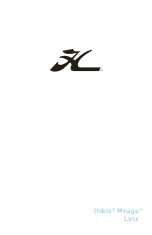
Hunter 50
CC
• Getting Underway
13.3
WARNING
!
!
Leaking fuel is a fire and explosion hazard. Personal
injury or death could occur.
DANGER
!
!
Explosive fuel vapors can become trapped in the
lower portions of the boat. Close all hatch covers,
windows, doors, and compartments while fueling
your boat.
1. Evacuate all occupied enclosures immediately.
2. Shut down engines and generator.
3. Turn off all electrical circuits.
4. Inform the dockmaster. Have a qualified technician
check the boat immediately to determine the source of
the odor.
5. Open the boat for natural ventilation.
6. When you can no longer smell fumes, locate the
source. Dispose of fuel in a safe, approved manner.
13.2 Starting the Engines
First, turn power at the battery switches to the On posi-
tion, energizing the battery and switch panel (detailed in
the DC Electric Chapter). Make sure that the bilge blower
hoses are properly attached and that blower openings
are not blocked.
It is important to follow the procedures to prevent electric
shock.
Check that bilge pumps are working by switching breaker
to MANUAL (OFF) position. Switch ON breaker for fresh
water pump to make sure it is working.
Check out the following equipment and accessories:
Seawater intakes that feed propulsion equipment
Navigation Lights
Throttle and shifter for smooth operation
Steering system ease of operation
•
•
•
•
WARNING
!
!
Using a damaged or improper cord for shore power
can cause electrical shock and serious injury. Use a
cord specifically designed for shore power connec-
tion. Do not use a household extension cord.
CAUTION
!
!
Water is an excellent conductor of electricity. Keep
shore power cord out of water. Do not operate any
AC device while you, or the cord, are in the water.
To prevent injury or equipment damage, keep all AC
electric system components dry.
WARNING
!
!
DO NOT disconnect the shore power cord to the boat
first. You could accidentally drop the cord into the
water, which may result in electrical shock and seri-
ous personal injury.
Check engine, and gear box oil level. Refer to the engine
manual for instructions. Add oil if needed.
Check the coolant level.
13.2.1 Running the Engines
Now it is time to start the engines. This is accomplished
by the following procedures:
1. First, move the throttle to the idle position and ensure
that the shift levers are in neutral.
2. Next, turn the switch to the “On” position. You will
then hear an audible alarm. This is the oil alarm and will
cease when the engines have started and the oil pres-
sure rises. You can also check the voltage gauges to
see if you actually have enough power in the batteries to
start the engines.
3. After checking the DC gauges, then start the engine
with the start switch.
4. Once the engine starts and the oil pressure builds, the
alarm will cease. If the alarm does not cease, shut down
the engines and check your oil levels. If normal, seek the
help of a professional mechanic.
Summary of Contents for 50CC
Page 1: ...Operator s Operator s Manual Manual Hunter 5 Hunter 50 0cc cc ...
Page 2: ......
Page 9: ...Introduction Introduction Hunter 50cc Hunter 50cc Chapter 1 Chapter 1 ...
Page 14: ...Hunter 50cc Introduction 1 6 Notes ...
Page 15: ...Documents Documents Forms Forms Hunter 50cc Hunter 50cc Chapter 2 Chapter 2 ...
Page 26: ...Hunter 50CC Documents and Forms Maintenance Log Date Maintenance Performed Hourmeter 2 12 ...
Page 27: ...Hunter 50CC Documents and Forms 2 13 Date Maintenance Performed Hourmeter Maintenance Log ...
Page 33: ...Hunter 50CC Documents and Forms 2 19 Spare Parts List ...
Page 34: ...Hunter 50CC Documents and Forms Dates of practice drills and onboard safety inspections 2 20 ...
Page 36: ...Hunter 50CC Documents and Forms Notes 2 22 ...
Page 37: ...DC 071609 Limited Limited Warranty Warranty Chapter 3 Chapter 3 ...
Page 38: ...This Page Intentionally Left Blank Hunter Limited Warranty 3 2 ...
Page 47: ...Boating Safety Boating Safety Hunter 50cc Hunter 50cc Chapter 4 Chapter 4 ...
Page 66: ...Hunter 50CC Boating Safety 4 20 Notes ...
Page 67: ...Fuel Systems Fuel Systems Hunter 50cc Hunter 50cc Chapter 5 Chapter 5 ...
Page 73: ...Fig 5 7 A Quick Fuel Filter Reference Hunter 50CC Fuel Systems 5 7 ...
Page 81: ...Underwater Underwater Gear Gear Hunter 50cc Hunter 50cc Chapter 6 Chapter 6 ...
Page 92: ...Hunter 50CC Underwater Gear 6 12 Notes ...
Page 93: ...DC Electrical DC Electrical Systems Systems Hunter 50cc Hunter 50cc Chapter 7 Chapter 7 ...
Page 104: ...NAV LIGHT BREAKER DECK LIGHT BEAKER D Hunter 50CC DC Electric 7 12 ...
Page 105: ...AC Electric AC Electric Systems Systems Hunter 50cc Hunter 50cc Chapter 8 Chapter 8 ...
Page 114: ...Hunter 50cc AC Electric Systems 8 10 Notes ...
Page 115: ...Water Systems Water Systems Hunter 50cc Hunter 50cc Chapter 9 Chapter 9 ...
Page 127: ...Waste Waste Systems Systems Hunter 50cc Hunter 50cc Chapter 10 Chapter 10 ...
Page 140: ...Notes Hunter 50CC Waste and Sanitation Systems 10 14 ...
Page 150: ...Hunter 50CC Engines and Transmissions 11 10 Notes ...
Page 151: ...Sails Sails and and Riggings Riggings Hunter 50cc Hunter 50cc Chapter 12 Chapter 12 ...
Page 164: ...12 14 CAMCLEAT 1 2 5 4 11 3 2 12 7 8 9 10 6 50cc DUAL END MAINSHEET PURCHASE ARRANGEMENT ...
Page 175: ...Hunter 50cc Hunter 50cc Getting Getting Underway Underway Chapter 13 Chapter 13 ...
Page 182: ...Hunter 50CC Getting Underway 13 8 Notes ...
Page 183: ...Maintenance Chapter 14 Chapter 14 Hunter 50cc Hunter 50cc ...
Page 195: ...Glossary Glossary Chapter 15 Chapter 15 Hunter 50cc Hunter 50cc ...
















































